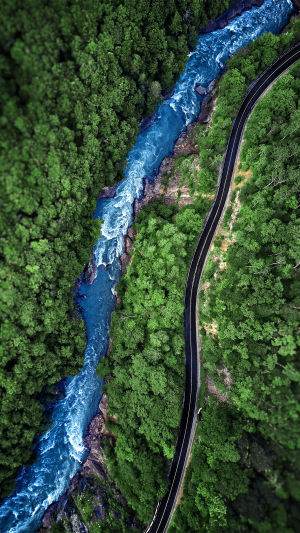A canyon is a valley with steep slopes and a depth greater than its width. It is usually developed in sections where tectonic movements lift and the valley slopes are composed of hard rocks, and canyons are most easily formed when the rate of ground uplift is coordinated with downcutting.
Nothing else interprets the corrosive nature of water as well as canyons. By eroding hard rock, the river carves its way through, sometimes over hundreds of years, creating incredibly large natural sculptures. Long, deep canyons are even more of a spectacle. So do you know what other more famous canyons are in the world? Let's find out!
1. Yarlung Tsangpo Grand Canyon
The Yarlung Zangbo Grand Canyon starts from Daduka village in Milin County in the north to Baxiqa village in Murdoch County in the south. Yarlung Zangbo Grand Canyon is 504.6 kilometres long, with an average depth of 2268 meters and the deepest depth of 6009 meters, with an average elevation of more than 3000 meters, making it the world's largest canyon.
The entire canyon area is interspersed with glaciers, sheer walls, steep slopes, mudslides, and huge rivers with huge waves, and the environment is very harsh. Many areas are still untouched, which is called "the last secret place on earth" and is one of the rare blank areas for geological work.
Due to the moisture and heat brought by the water and air passage of the Grand Canyon, it has created a beautiful natural environment in southeast Tibet, which is known as the "South of Tibet".
2. Capertee Canyon, Australia
Capertee Canyon in Australia. It is the largest canyon in Australia, famous for its solid terrain and towering sandstone cliffs. Because of its age, Capertee Canyon is not as deep as the other canyons on this list, but it is massive. 0.6 miles wider than the Grand Canyon.
There are many ways to take in the majestic views of the canyon. If you are physically fit, you can choose to hike the sandstone plateau. A walk as short as an hour or as long as five days will give you spectacular views of the canyon and the unique features of this landscape, including monsoon rainforests, rocky country, upland bogs, woodlands, and rivers.
3. Grand Canyon, USA
The Grand Canyon of the United States is a world-renowned natural wonder with the Colorado River running through it, and it is one of the natural heritage sites selected for protection by UNESCO.
Located on the Kaibab Plateau in northwestern Arizona, the Grand Canyon is one of the most magnificent sights on earth. The Colorado River cuts a total of 19 major canyons in the Colorado Plateau, with a total area of 2,724.7 square kilometres, of which the deepest, widest, and longest one is the Grand Canyon.
It is 446 kilometres long, making it one of the longest canyons in the world. The top of the canyon is 6 to 28 kilometres wide and the deepest is 1,800 meters. The water at the bottom of the valley is less than 1,000 meters wide and increases to a depth of 18 meters in summer when the snow and ice melt water is present. The rocks are mostly red.
4. Colca Grand Canyon
The Colca Canyon is one of the main tourist destinations in Peru. For adventurous travellers, the river through this canyon is an irresistible challenge. The rafting in the fast flow is a great opportunity for travellers to have an adventure.
In the canyon, the climate can vary greatly from the coldest to a semi-tropical climate at the bottom, from 1 or 2 degrees Celsius in the morning and evening to 25 degrees Celsius at noon, with daily temperature variations.
More than 20 species of cacti and 170 species of birds of prey grow here, the largest of which is the mountain eagle, each with a wing length of about 1 meter 20, considered to be the largest bird of prey in the world.





